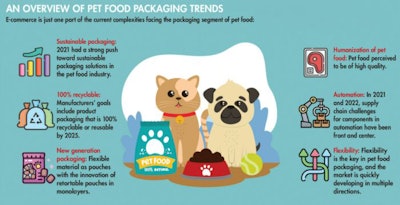
The COVID-19 pandemic created significant shifts in how people purchase goods and services, and pet food saw the same bump in e-commerce that other grocery and home products did. This has led to some reckoning in the pet space regarding how to most effectively package pet food and treats purchased online, from both branding and technical standpoints.
“E-commerce continues to grow, especially in the pet category,” said Thomas Morsheimer with reclosable flexible packaging innovations company Fresh-Lock and market development manager for Presto Products Company. “The packaging requirements for e-commerce channels can be vastly different from that of traditional brick-and-mortar channels. The primary packaging still needs to provide all the convenience and performance to maintain product freshness and deliver clear nutritional information. But this path also requires robust, sustainable, integrated secondary packaging to ensure consumers' expectations are met and they are delighted when products hit their doorstep.”
The rise of fresh pet food and subscription models
Direct-to-consumer (DTC) pet food sales are up, and many of the current subscription services cater to premium- and superpremium-inclined pet owners.
“This trend is impacting packaging as fresh pet food (a big player in subscription-based pet food models) requires packaging that will ensure the preservation of flavor and freshness and stand up to the cold case rigors,” said Diana Courtepatte, director of marketing for Canada-based printing company TC Transcontinental. “Having the right packaging structure with high barrier properties that will preserve the freshness and palatability of the food will be vital for this pet food format. We see one of the popular fresh pet food formats are packaged in chubb films and stand-up packages that must protect the fresh food and flavor and extend shelf life. These specialty films and bags must not only preserve the freshness of the product, but they need to be durable enough to stand up to the rigors of the supply chain and protect the product.”
Hand-in-hand with this particular e-commerce trend is an increase in consumer expectations.
“The market is demanding increased volume and quality — especially for e-commerce or DTC packaging — without any compromise on price,” said Susan Ellison, joint owner at United Kingdom-based packaging and labeling company OPM Group. “We saw this trend gather steam throughout the pandemic as consumers were forced to rely on online shopping, and it hasn’t lost momentum in the post-pandemic market.”
Of course, price is a considerable challenge right now.
“The supply chain is stretched thin, which is causing price increases for raw materials,” said Ellison. “Previously, this was less of an issue, as consumers were willing to pay more for pet food they considered to be luxury or premium, but the cost of living crisis has complicated the short-term picture somewhat. A recent RSPCA study in the United Kingdom found that 78% of pet owners were worried about rampant inflation and a potential recession would affect the quality of life of their animals. So converters must create packaging that looks and feels premium, performs well on-shelf and in transit, and is ethically produced — and they must do all that as affordably and quickly as possible to minimize costs that are passed onto consumers.”
The demands of e-commerce packaging
Packaging in the e-commerce space must be able to tell a story while withstanding the realities of shipping.
“With pet product sales increasing, especially through online retailers, packaging must be designed for the rigors and challenges of e-commerce,” said Dave MacDonald, vice president of sales for flexible packaging solutions company ProAmpac. “Bag strength, in addition to functionality, is a much bigger part of the packaging design conversation than in years past. By offering convenience, cost and efficiency, e-commerce is emerging as a key driver of growth in the category. Consumers are not limited to their local store and can seek out specific products with numerous online retailers.
“To create e-commerce-ready pet food packaging, brand owners need to consider reductions in secondary and tertiary packaging,” said MacDonald. “E-commerce packaging trends are equally impacted by material downgauging, so primary packaging needs to meet specific integrity requirements. Understanding the rigors of e-commerce includes puncture and tear resistance, scuff-resistant graphics and sturdy materials with easy-open options.”
Under these conditions and needs, what will success look like?
“Customized pet food subscriptions, personalized packs and limited-edition seasonal products — for example, Christmas-themed pet foods and snacks — have grown in popularity among consumers,” said Ellison. “We expect digital printing and flexible packaging to become even more important than they are today as these trends continue, and the most agile brands and packaging partners will reap the rewards.”
An overview of pet food packaging trends
E-commerce is just one part of the current complexities facing the packaging segment of pet food:

Source: The Pet Food Competence Network
Is pet food e-commerce growth beginning to slow?


















